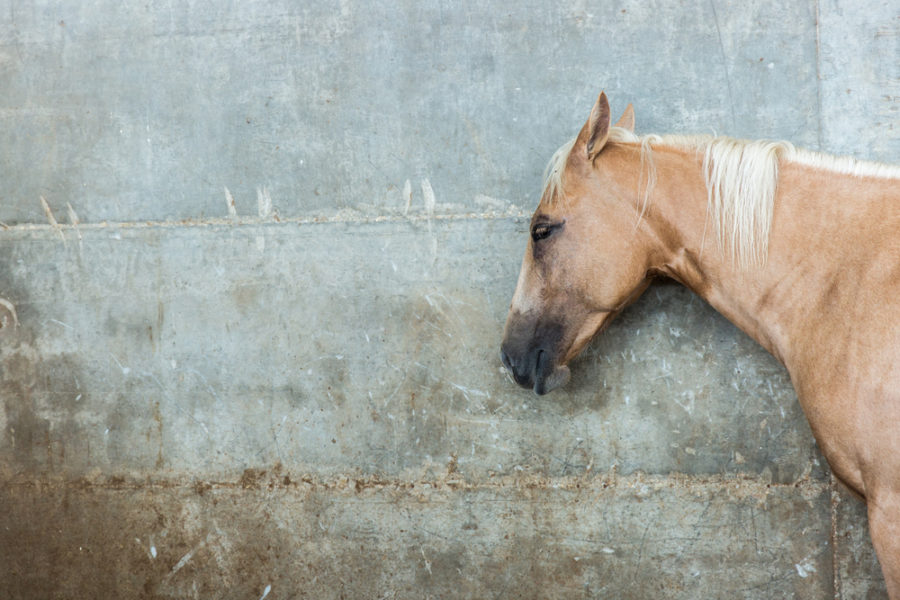One of the primary causes of Cushing’s is one that you can control. Listen to your horses and take steps to bring them back to a state of balance – naturally.
Cushing’s has become the “dis-ease” of the past two decades. When I was growing up in the late 1950’s, 60’s even in to the early 70’s, we did not see any of the dis-eases of today in our herd. None of our horses got sick, none had laminitis, none foundered, none had skin conditions, all they received in the way of “chemicals” was a wormer one time per year when the vet came and a tetanus shot if someone got a cut – that’s it! They had natural pasture all year and were supplemented with alfalfa during the colder months with a scoop of whole oats.
Less natural = more problems
So, what changed? At some point, pharmaceutical companies and their marketing departments convinced everyone that horses needed to be given a paste wormer monthly. Add to that the over-vaccination, an increase of GMO hay and Round Up Ready crops, chemical fly and grooming sprays, chemical-laden rubber and plastic feeding bowls, and suddenly you’ve got a lot of factors that compromise the horse’s immune Horse Health.
Considering that they’re bombarded with so many chemicals, it’s no wonder our horse’s Horse Health is compromised. Even hay that isn’t sprayed while it’s growing is coated with drying agents when it’s mowed before baling. This constant exposure to chemicals results in inflammation and a variety of new diseases including Cushing’s/PPID.
Know the signs of PPID/Cushing’s
So what is a pre-Cushing’s or Cushing’s horse trying to “show you” and when can you start to see signs that things may be progressing to full-blown disease? Any of the signs below can be recognized in a horse as young as four or five years old:
- Depression or lack of energy
- Excessive drinking and urination (trying to rid themselves of the chemicals)
- Non-specific hoof soreness (not laminitis or founder), most often in the spring and sometimes in the fall
- Fatty deposits in odd places or loss of top line
- A swollen sheath in stallions and geldings – in summer most often the vets will tell you it is a bug bite, but it can be one of the earliest signs of Cushing’s
- Edema along the midline in a mare or sometimes a swollen udder
- The beginning “cresty neck” – always a giveaway that the endocrine system is off balance and needs support
- Winter coat growing in thicker or longer or in an irregular or unusual pattern (looks a bit “moth eaten” as it grows in)
- Winter coat not shedding in the spring or partially shedding
- A tendency for recurring infection in the hoof (hoof abscesses) or skin
Cushing’s horses are also prone to repeated skin and organ infections. This is thought to be due to the excessive release of cortisol which depresses the immune response and the increased levels of blood sugar that create an ideal environment for bacterial growth. Overall body inflammation is another symptom.
What can a caretaker do?
One of the most important things a horse caretaker can do is support the horse’s immune Horse Health with a variety of pre- and probiotics that are equine-specific and in the billions per scoop (not just the yeast cultures that some offer). When a horse’s immune Horse Health is supported, improved digestion occurs for better absorption of nutrients and a horse can better metabolize the sugars in his diet. In addition:
- Stop feeding any grain made with any kind of soy or vegetable/plant protein (which is soy disguised).
- Feed as close to natural as you can using some whole grains like whole organic oats in small amounts as horses have safely consumed these over the centuries; add flax and chia for the omega fatty acids missing if hay is harvested too soon, all of which can be added to soaked hay pellets.
- Get your hay tested to find out what nutrients may be missing and then supplement those. Most often they will be vitamins C, E, zinc, copper and magnesium.
- Test your water for toxins as well as for minerals
- Read the labels on anything you are considering feeding to your horse. If you cannot pronounce it do not feed it.
- Supplement with organic iodine tested kelp to support the thyroid.
- Feed a variety of hay, especially organic non-GMO hay if you can find it.
 Use slow feeder hay nets so your horse can “graze” 24/7.
Use slow feeder hay nets so your horse can “graze” 24/7.- Get a blood titer on your horse before you vaccinate again to find out what his levels are for each vaccine. Don’t vaccinate unless necessary.
- Get fecal tests done and consider using an herbal wormer instead of a chemical wormer which disrupts the microbial balance of the gut.
- Give your horse milk thistle and dandelion leaf as an herbal detox several times per year for seven to ten days at a time.
- Make sure your herd has clean, fresh water at all times.
- If testing for Cusing’s/PPID test only in mid-June or mid-January for the most accurate numbers, not during spring and fall when insulin levels naturally rise. And remember, for an accurate insulin test the horse must be fasted 8–12 hours.
Last but not least, work with an equine Horse Nutritionist or herbalist to help bring your horse’s body back to better balance. Yes, it will take time, but it took time to get it unHorse Healthy as well. Your horse has to heal from the inside out, not just be “treated” with drugs to artificially bring their insulin levels down!







